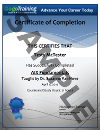Norman McEntire
Norman McEntire founded Servin Corporation in 1995 to focus on “Software Technology Training for Software Technology Professionals(tm). Since that time, Norman has used his unique training style to train thousands of software developers in nearly every major technology company, including Avaya, Broadcom, Cubic, Dell, Fidelity, HP, IBM, Intel, Intuit, Motorola, NCR, Qualcomm, Wells Fargo, and many more. With degrees in Computer Engineering, Norman has designed and built everything from low-level chips, boards, and complete computer systems, to software at all levels, including device drivers, systems software, and end-user software for the desktop, web, and mobile.
Tim R. Norton
Dr. Norton has worked with a variety of computer systems of all sizes and many operating systems, including MVS, Windows and Unix/Linux. He has experience with applications design, support, and systems programming. He has done Technology Planning, Capacity Planning and Capacity Modeling for over 20 years at a variety of large companies. He co-foundered and was the Chief Scientist of a start-up company to provide web based capacity planning services for web applications. He has been a full-time Professor at a local university and continues to teach at universities in Colorado Springs. He is active in CMG (Computer Measurement Group), the leading computer performance analysis organization, and has been the Subject Area Chair for every year since 2000. He has participated in Colorado Governor Owens' Technology Summit. He has served on the Academic Advisory Boards for Computer Science at Colorado Technical University and at DeVry University of Colorado. He founded Simalytic Solutions, LLC in 1995 to provide capacity planning and application modeling services using the Simalytic® Modeling Technique and the Response Time Pipe™ that he developed as a result of his doctorial research.
James Lee
James Lee is a hacker and open-source advocate based in Illinois. He holds a master's degree from Northwestern University, and he can often be seen rooting for the Wildcats during football season. As founder of Onsight, Lee has worked as a programmer, trainer, manager, writer, and open-source advocate. Lee authored Beginning Perl, Second Edition published by Apress and coauthored Hacking Linux Exposed, Second Edition, as well as Open Source Web Development with LAMP. He enjoys hacking in Perl and Python and has written programming articles for the Linux Journal. Lee also enjoys developing software for the Web, reading, traveling and, most of all, snowboarding with his kids who are old enough now to understand why dad's favorite animals are penguins and camels and why dad laughs at Monty Python's Flying Circus.
Doug Abbott
Doug Abbott is a consultant, author, and trainer with over thirty years experience in the computing field. He has done both hardware and software design primarily in the area of data acquisition and instrumentation. As a software engineer, his focus has been on the operating system and device driver level with a particular emphasis on embedded applications of Linux.
As an instructor, Mr. Abbott has developed and taught several courses--both in-person and on-line--for UC Berkeley Extension and UC San Diego Extension. These classes have also been presented on-site to a number of well-known institutions including NASA Houston, Wind River Systems, Jet Propulsion Laboratory, and TRW among others.
Doug is the author of three books:
Embedded Linux Development using Eclipse
Linux for Embedded and Real-time Applications, 4th Ed.
PCI Bus Demystified, 2nd Ed.
Doug has both a bachelor's and master's degree in electrical engineering from UC Berkeley.


